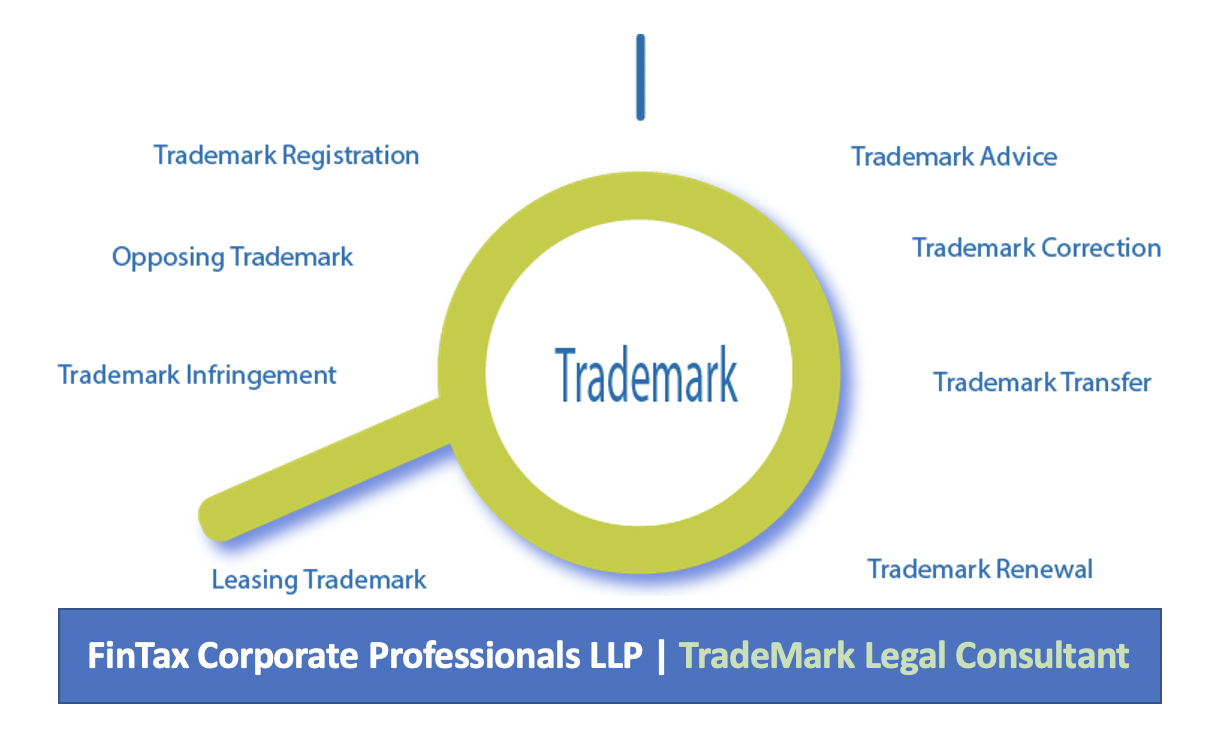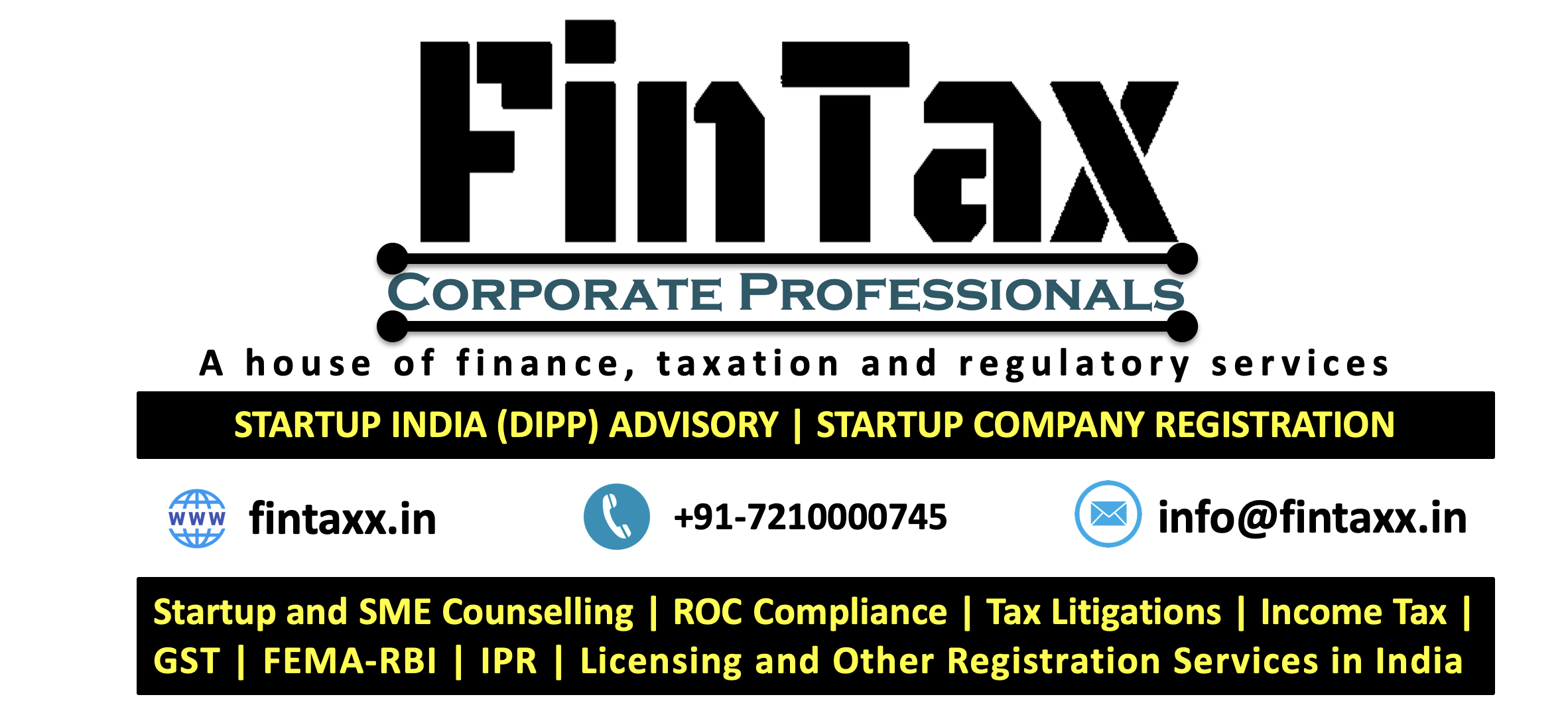TradeMark Consultants, Trademark Registration, Brand Registration, trademark search online, Trademark Registration Fee, Trademark Agent, Trademark Lawyer, TM Registration online, Brand registration online, Logo registration, Trademark Objection reply, Trademark fee, Top 100 Trademark Registration Consultants, trademark class
FINTAX CORPORATE PROFESSIOANALS LLP
LOOKING for a Trademark Registration ? Call us +91-7210000745 at FinTax Corporate Professionals LLP. Free TM Preliminary Search, Complete guidance and advisory. File Trademark Application, TM Objection Reply, Hearing attend. Our fee starts @ 1500/ + actual Govt Fee. We serve PAN India clients. EMAIL us: at info@fintaxx.in
TradeMark Registration in India
be a Legal Owner of your Brand
TradeMark for Brand Name ( Word Mark) or Logo or Both
Our Pricing starts @ Rs 1200/- plus Rs 4500 Govt fee
Within 24 Hours Filing | Use TM Mark after filing application and R after Success Registration.
Trademark Registration Process
Step 1: We collect documents ( ID/Address proof of applicant, Power of Attorney, Brand Name/Logo)
Step 2: File Application within 24 hours ( except saturday & sunday)
Step 4: Get TM Registration Certificate ( if there is no objection from Registrar)
Whole Process takes 6-8 months from application filing to Registration certificate issued.
Trademark Objection reply Filing Process
When there is any objection raised by Registrar for similar or identical or any other issues with your filed TM, You will get a Show Cause Notice ( SCN) from TM Regisrar to reply within 30 days.
What to do here?
Hire a Trademark Consultant and show him the said SCN,
Step 1: Get a well Legal Reply reply from Trademark Consultant
Step 2: File reply online ( if TM Applied Online) or File Offline within 30days
Step 3: Either your reply will get accepted if found valid or Registrar Will serve you notice to attend for hearing
![TradeMark Consultants in]()
Trademark Class List
Trademark (TM) classes for Goods
If a product cannot be classified with the aid of the List of Classes, the Explanatory Notes and the Alphabetical List, the following remarks set forth the criteria to be applied:
(a) A finished product is in principle classified according to its function or purpose. If the function or purpose of a finished product is not mentioned in any class heading, the finished product is classified by analogy with other comparable finished products, indicated in the Alphabetical List. If none is found, other subsidiary criteria, such as that of the material of which the product is made or its mode of operation, are applied.
(b) A finished product which is a multipurpose composite object (e.g., clocks incorporating radios) may be classified in all classes that correspond to any of its functions or intended purposes. If those functions or purposes are not mentioned in any class heading, other criteria, indicated under (a), above, are to be applied.
(c) Raw materials, unworked or semi-worked, are in principle classified according to the material of which they consist.
(d) Goods intended to form part of another product are in principle classified in the same class as that product only in cases where the same type of goods cannot normally be used for another purpose. In all other cases, the criterion indicated under (a), above, applies.
(e) When a product, whether finished or not, is classified according to the material of which it is made, and it is made of different materials, the product is in principle classified according to the material which predominates.
(f) Cases adapted to the product they are intended to contain are in principle classified in the same class as the product.
Trademark (TM) Class 1
Chemicals used in industry, science and photography, as well as in agriculture, horticulture and forestry;
unprocessed artificial resins, unprocessed plastics;
manures;
fire extinguishing compositions;
tempering and soldering preparations;
chemical substances for preserving foodstuffs;
tanning substances;
adhesives used in industry.
Trademark (TM) Class 2
Paints, varnishes, lacquers;
preservatives against rust and against deterioration of wood;
colorants;
mordants;
raw natural resins;
metals in foil and powder form for painters, decorators, printers and artists.
Trademark (TM) Class 3
Bleaching preparations and other substances for laundry use;
cleaning, polishing, scouring and abrasive preparations;
soaps;
perfumery, essential oils, cosmetics, hair lotions;
dentifrices.
Trademark (TM) Class 4
Industrial oils and greases;
lubricants;
dust absorbing, wetting and binding compositions;
fuels (including motor spirit) and illuminants;
candles and wicks for lighting.
Trademark (TM) Class 5
Pharmaceutical and veterinary preparations; sanitary preparations for medical purposes;
dietetic substances adapted for medical use, food for babies;
plasters, materials for dressings;
material for stopping teeth, dental wax;
disinfectants;
preparations for destroying vermin;
fungicides, herbicides.
Trademark (TM) Class 6
Common metals and their alloys;
metal building materials;
transportable buildings of metal;
materials of metal for railway tracks;
non-electric cables and wires of common metal;
ironmongery, small items of metal hardware;
pipes and tubes of metal;
safes;
goods of common metal not included in other classes;
ores.
Trademark (TM) Class 7
Machines and machine tools;
motors and engines (except for land vehicles);
machine coupling and transmission components (except for land vehicles);
agricultural implements other than hand-operated;
incubators for eggs.
Trademark (TM) Class 8
Hand tools and implements (hand-operated);
cutlery;
side arms;
razors.
Trademark (TM) Class 9
Scientific, nautical, surveying, photographic, cinematographic, optical, weighing, measuring, signalling, checking (supervision), life-saving and teaching apparatus and instruments; apparatus and instruments for conducting, switching, transforming, accumulating, regulating or controlling electricity;
apparatus for recording, transmission or reproduction of sound or images;
magnetic data carriers, recording discs;
automatic vending machines and mechanisms for coin-operated apparatus;
cash registers, calculating machines, data processing equipment and computers;
fire-extinguishing apparatus.
Trademark (TM) Class 10
Surgical, medical, dental and veterinary apparatus and instruments, artificial limbs, eyes and teeth;
orthopedic articles;
suture materials.
Trademark (TM) Class 11
Apparatus for lighting, heating, steam generating, cooking, refrigerating, drying, ventilating, water supply and sanitary purposes.
Trademark (TM) Class 12
Vehicles;
apparatus for locomotion by land, air or water.
Trademark (TM) Class 13
Firearms;
ammunition and projectiles;
explosives;
fireworks.
Trademark (TM) Class 14
Precious metals and their alloys and goods in precious metals or coated therewith, not included in other classes;
jewellery, precious stones;
horological and chronometric instruments.
Trademark (TM) Class 15
Musical instruments.
Trademark (TM) Class 16
Paper, cardboard and goods made from these materials, not included in other classes;
printed matter;
bookbinding material;
photographs;
stationery;
adhesives for stationery or household purposes;
artists” materials;
paint brushes;
typewriters and office requisites (except furniture);
instructional and teaching material (except apparatus);
plastic materials for packaging (not included in other classes);
printers” type;
printing blocks.
Trademark (TM) Class 17
Rubber, gutta-percha, gum, asbestos, mica and goods made from these materials and not included in other classes;
plastics in extruded form for use in manufacture;
packing, stopping and insulating materials;
flexible pipes, not of metal.
Trademark (TM) Class 18
Leather and imitations of leather, and goods made of these materials and not included in other classes;
animal skins, hides;
trunks and travelling bags;
umbrellas, parasols and walking sticks;
whips, harness and saddlery.
Trademark (TM) Class 19
Building materials (non-metallic);
non-metallic rigid pipes for building;
asphalt, pitch and bitumen;
non-metallic transportable buildings;
monuments, not of metal.
Trademark (TM) Class 20
Furniture, mirrors, picture frames;
goods (not included in other classes) of wood, cork, reed, cane, wicker, horn, bone, ivory, whalebone, shell, amber, mother-of-pearl, meerschaum and substitutes for all these materials, or of plastics.
Trademark (TM) Class 21
Household or kitchen utensils and containers (not of precious metal or coated therewith);
combs and sponges;
brushes (except paint brushes);
brush-making materials;
articles for cleaning purposes;
steelwool;
unworked or semi-worked glass (except glass used in building);
glassware, porcelain and earthenware not included in other classes.
Trademark (TM) Class 22
Ropes, string, nets, tents, awnings, tarpaulins, sails, sacks and bags (not included in other classes);
padding and stuffing materials (except of rubber or plastics);
raw fibrous textile materials.
Trademark (TM) Class 23
Yarns and threads, for textile use.
Trademark (TM) Class 24
Textiles and textile goods, not included in other classes;
bed and table covers.
Trademark (TM) Class 25
Clothing, footwear, headgear.
Trademark (TM) Class 26
Lace and embroidery, ribbons and braid;
buttons, hooks and eyes, pins and needles;
artificial flowers.
Trademark (TM) Class 27
Carpets, rugs, mats and matting, linoleum and other materials for covering existing floors;
wall hangings (non-textile).
Explanatory Note
Class 27 includes mainly products intended to be added as furnishings to previously constructed floors and walls.
Trademark (TM) Class 28
Games and playthings;
gymnastic and sporting articles not included in other classes;
decorations for Christmas trees.
Trademark (TM) Class 29
Meat, fish, poultry and game;
meat extracts;
preserved, dried and cooked fruits and vegetables;
jellies, jams, compotes;
eggs, milk and milk products;
edible oils and fats.
Trademark (TM) Class 30
Coffee, tea, cocoa, sugar, rice, tapioca, sago, artificial coffee;
flour and preparations made from cereals, bread, pastry and confectionery, ices;
honey, treacle;
yeast, baking-powder;
salt, mustard;
vinegar, sauces (condiments);
spices;
ice.
Trademark (TM) Class 31
Agricultural, horticultural and forestry products and grains not included in other classes;
live animals;
fresh fruits and vegetables;
seeds, natural plants and flowers;
foodstuffs for animals;
malt.
Trademark (TM) Class 32
Beers;
mineral and aerated waters and other non-alcoholic drinks;
fruit drinks and fruit juices;
syrups and other preparations for making beverages.
Trademark (TM) Class 33
Alcoholic beverages (except beers).
Trademark (TM) Class 34
Tobacco;
smokers” articles;
matches.
Trademark (TM) Services class
If a service cannot be classified with the aid of the List of Classes, the Explanatory Notes and the Alphabetical List, the following remarks set forth the criteria to be applied:
(a) Services are in principle classified according to the branches of activities specified in the headings of the service classes and in their Explanatory Notes or, if not specified, by analogy with other comparable services indicated in the Alphabetical List.
(b) Rental services are in principle classified in the same classes as the services provided by means of the rented objects (e.g., Rental of telephones, covered by Class 38).
(c) Services that provide advice, information or consultation are in principle classified in the same classes as the services that correspond to the subject matter of the advice, information or consultation, e.g., transportation consultancy (Cl. 39), business management consultancy (Cl. 35), financial consultancy (Cl. 36), beauty consultancy (Cl. 44). The rendering of the advice, information or consultancy by electronic means (e.g., telephone, computer) does not affect the classification of these services.
Trademark (TM) Class 35
Advertising;
business management;
business administration;
office functions.
Trademark (TM) Class 36
Insurance;
financial affairs;
monetary affairs;
real estate affairs.
Trademark (TM) Class 37
Building construction;
repair;
installation services.
Trademark (TM) Class 38
Telecommunications.
Trademark (TM) Class 39
Transport;
packaging and storage of goods;
travel arrangement.
Trademark (TM) Class 40
Treatment of materials.
Trademark (TM) Class 41
Education;
providing of training;
entertainment;
sporting and cultural activities.
Trademark (TM) Class 42
Scientific and technological services and research and design relating thereto;
industrial analysis and research services;
design and development of computer hardware and software.
Trademark (TM) Class 43
Services for providing food and drink;
temporary accommodation.
Trademark (TM) Class 44
Medical services;
veterinary services;
hygienic and beauty care for human beings or animals;
agriculture, horticulture and forestry services.
Trademark (TM) Class 45
Personal and social services rendered by others to meet the needs of individuals; security services for the protection of property and individuals; legal services (earlier in the class 42);
![Registered Trademark Agent in]()







